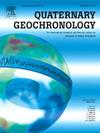New age model for Onepoto maar, Auckland, New Zealand, based on a revised tephrochronology of the lake sediment sequence
IF 2.5
2区 地球科学
Q3 GEOGRAPHY, PHYSICAL
引用次数: 0
Abstract
Tephrochronology has proven to be a reliable dating tool in the context of northern New Zealand lakes due to the numerous volcanic centres on the North Island that have repeatedly erupted during the late Quaternary. The widely-distributed tephras often have distinctive geochemical compositions with many of these tephra layers preserved in the sediments that infill maar lakes in the Auckland Volcanic Field (AVF). Here, we present a revised age model for the Onepoto Maar lake sediment sequence, using 14 rhyolitic, seven basaltic, and two andesitic tephra layers with assigned ages as markers. These were integrated with bulk organic matter and pollen-derived radiocarbon ages to establish the new age-depth model. Improvement of the age model for the pre-45 ka section of the Onepoto record was based on the usage of tephras with refined ages: Eg2, Eg4, and Eg10 (Taranaki Maunga-sourced) and AVF D, AVF C, AVF B, and 90 AVF (AVF-sourced). The correlation of the Onepoto tephra horizons to the recently refined, multi-method derived, age model of the Ōrākei maar tephra sequence has improved the robustness of the new Onepoto age model. Consequently, this approach has enabled development of reliable age assignations for tephra layers contained in the Onepoto sediments beyond the limit of 14C dating. Accurate chronologies for lake sediment sequences, such as the one presented here, are vital for paleoenvironmental research. Thus, the revised Onepoto age model improves upon previous models for our study site, offering more robust age control for regional paleoclimate studies covering the last two glacial cycles. It will also allow the extension of the existing high-resolution paleoenvironmental and paleoclimatic records developed from the AVF maar lakes beyond MIS 5e to at least late MIS 7.
新西兰奥克兰Onepoto maar的新时代模型,基于湖泊沉积物序列的修订色代学
由于北岛上的众多火山中心在晚第四纪期间反复爆发,在新西兰北部湖泊的背景下,温度年代学已被证明是一种可靠的测年工具。广泛分布的麻风层通常具有独特的地球化学组成,其中许多麻风层保存在填充奥克兰火山场(AVF) maar湖的沉积物中。本文采用14个流纹岩层、7个玄武岩层和2个安山岩层作为年龄标志,建立了Onepoto Maar湖沉积层序的修正年龄模型。将这些数据与总体有机质和花粉来源的放射性碳年龄相结合,建立了新的年龄-深度模型。Onepoto记录前45 ka剖面的年龄模型改进基于使用细化年龄的tephras: Eg2、Eg4和Eg10 (Taranaki maunga来源)和AVF D、AVF C、AVF B和90 AVF (AVF来源)。Onepoto tephra层位与最近改进的多方法推导的Ōrākei maar tephra层序年龄模型的相关性提高了新Onepoto年龄模型的鲁棒性。因此,这种方法能够对Onepoto沉积物中含有的超出14C定年限制的温层进行可靠的年龄分配。湖泊沉积物序列的准确年表,如这里展示的,对古环境研究至关重要。因此,修订后的Onepoto年龄模型改进了我们研究地点以前的模型,为覆盖最后两个冰期旋回的区域古气候研究提供了更强大的年龄控制。它还可以将现有的高分辨率古环境和古气候记录从AVF maar湖泊扩展到MIS 5e以上,至少延伸到MIS 7晚期。
本文章由计算机程序翻译,如有差异,请以英文原文为准。
求助全文
约1分钟内获得全文
求助全文
来源期刊

Quaternary Geochronology
地学-地球化学与地球物理
CiteScore
4.40
自引率
22.20%
发文量
130
审稿时长
20 weeks
期刊介绍:
Quaternary Geochronology is an international journal devoted to the publication of the highest-quality, peer-reviewed articles on all aspects of dating methods applicable to the Quaternary Period - the last 2.6 million years of Earth history. Reliable ages are fundamental to place changes in climates, landscapes, flora and fauna - including the evolution and ecological impact of humans - in their correct temporal sequence, and to understand the tempo and mode of geological and biological processes.
 求助内容:
求助内容: 应助结果提醒方式:
应助结果提醒方式:


